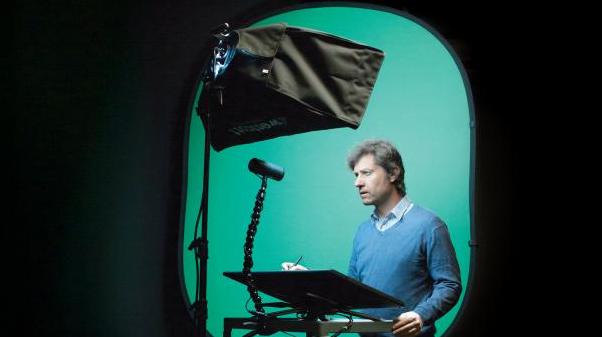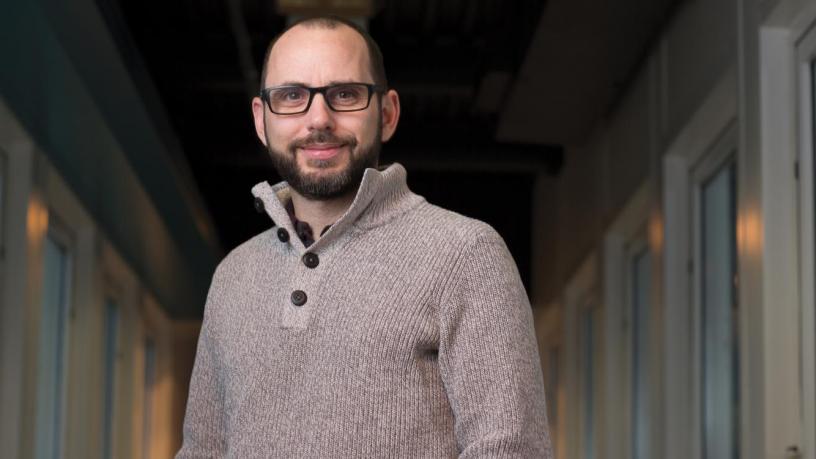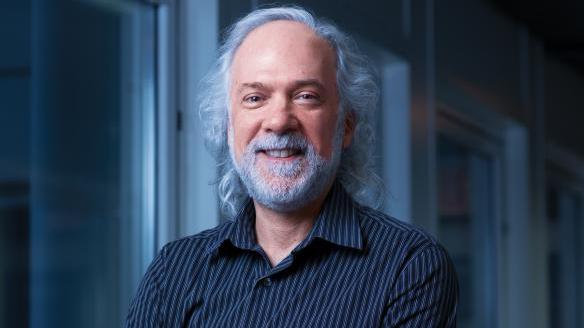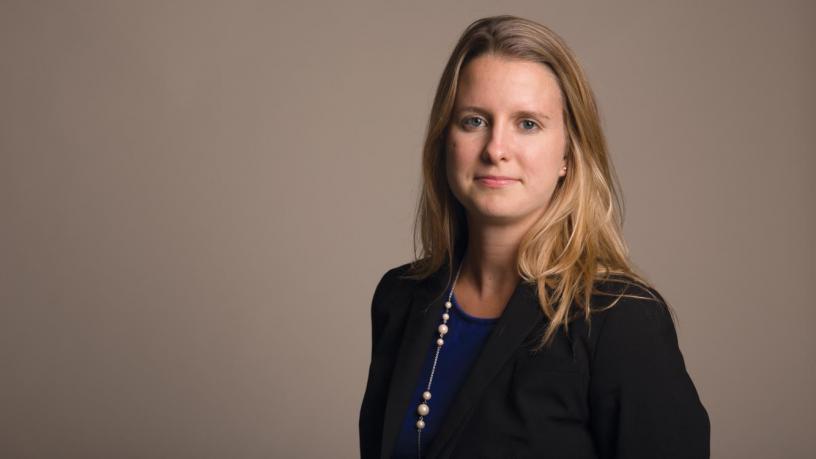Tinkering with Course Design

What does it take to make sure students of science, technology, engineering, and math (STEM) not only graduate technologically competent, but also are ready to take active roles in a dynamic workforce?
The answer seems to lie in changing the way courses are taught. At Columbia Engineering, several instructors are exploring innovative methods of teaching that include more hands-on experience, applicable knowledge, and insight into the process of design.
Even the way the classroom operates is fair game for these teaching innovators, one of whom is Michael Collins, Vikram S. Pandit Professor of Computer Science, who has found a “flipped classroom” approach to teaching allows students to better absorb course material.
In a flipped classroom, students are assigned video lectures, which they watch on their own time. Collins splits the class into small groups and meets for an hour a week with each group, giving a brief recap of the week’s material, then working through three to four problems with the students. The students have a few minutes to figure out each problem before Collins explains the solutions and answers questions.
“The small group sessions allow us to go much deeper within the material, in a setting that encourages much more interaction between the students and the professor,” he says. “It’s a great chance for the students to test their understanding of the material and ask questions and for us to have an open discussion about the material.”
Collins says the flipped classroom has changed his role dramatically, and that, though recording lectures can be more time consuming, it results in a resource that can be used over many years.
In terms of assignments for the class, a flipped classroom follows the usual format: four homework assignments, each involving analytical questions and programming assignments; a midterm; and a final. But it allows students to digest the material at their own pace and have an additional hour each week to go over problems with the professor.

Michael Collins records lectures for his “flipped classroom.” Students are assigned video lectures, which they watch on their own time, and then they meet for an hour a week in groups with Collins. (Photo by Jeffrey Schifman)
Engaging Them Early
Students might think they want to major in engineering, but some of their first-year courses can seem technical and dry.
“I’m in favor of anything that helps students develop a love for the subject being taught, so they will apply themselves and learn it,” says David Vallancourt, senior lecturer in circuits and systems in the Department of Electrical Engineering.
So, in 2011, Vallancourt created a course called the Art of Engineering (AoE) for first-year students.
AoE comprises four components: weekly lectures intended to expose the students to real-world engineering practice in all disciplines; a choice of hands-on projects in a specific engineering field; a class-wide common design project; and instruction in the use of MATLAB.
“Everything but the MATLAB component changes from semester to semester,” says Vallancourt. “It’s like jazz—I never do the same thing exactly the same way twice. We want to give students a satisfying, hands-on, deep engineering experience that demonstrates how much fun engineering can be.”
Chloé Blanchard, an undergraduate TA for AoE, says this is what students need and describes the modern engineering student as versatile and well-rounded because of these new techniques.

Adam Cannon, Senior Lecturer in Discipline, Department of Computer Science
(Photos by Jeffrey Schifman)

David Vallancourt, Senior Lecturer in Circuits and Systems, Department of Electrical Engineering.
(Photos by Jeffrey Schifman)
Stretching the Scope of Scientific Scholarship
Adam Cannon, senior lecturer and associate chair for undergraduate education in the Department of Computer Science (CS), says there is strong student demand and an educational need for computer science courses designed for the liberal arts major.
“While traditional computer science literacy courses for non-computer-science majors exist, they usually provide a broad introduction to the field,” says Cannon. “While this is a good thing, I believe students want more. They want real computational skills that they can apply in their own lives and in their own disciplines.”
The challenge, he says, is that there is no one-size-fits-all solution for a CS education component to a liberal arts degree. His new course—Computing in Context—departs from the traditional CS concepts course structure in an attempt to better serve the wide range of students seeking liberal arts degrees.
The computer science concepts component consists of two lectures a week during the first half of the semester and one lecture a week during the second half of the semester. Topics include algorithmic problem solving, basic computer programming, introduction to the Internet and the World Wide Web, and an introduction to databases.
Domain-specific components consist of one recitation each week during the first half of the semester and one recitation plus one lecture each week during the second half of the semester. The purpose of this component is to apply each week’s computer science lessons in a specific context.
“When registering for the course, students also register for a specific track that they will study for the entire semester,” says Cannon. “Homework assignments and computing projects will be specific to each context and, ultimately, the variety of contexts offered will be demand- and resource-driven. To start, we are offering digital humanities, computing for the social sciences, and computing for economics and finance.”
Working with Cannon currently are full-time faculty from other relevant departments, including Dennis Tenen, assistant professor of English and comparative literature; Matthew Jones, professor of contemporary civilization; and Karl Sigman, professor of industrial engineering and operations research.
“We will be digitizing the context lectures so that in future iterations of the course we can use a flipped classroom approach,” says Cannon. “In this way, we will add contexts from year to year, building up an online bank. Ultimately the course, to some degree, will have a choose-your-own-adventure flavor where students will have a very wide range of context tracks to choose from.”
Cannon says, given the current pervasive nature of computation and, more importantly, computational thinking in disciplines across the University, the way computer science is taught to those who do not major in the science is a “unique challenge.”
“This course is an experiment,” he says. “We’re trying something different and we’re excited to see the outcome.”
Emphasizing Concept Creation in Continuing Education
Innovative courses and educational tools are just as important in graduate instruction, says Katherine Reuther, lecturer in biomedical engineering (BME).
“While BME undergraduates receive broad, structured training in many aspects of biomedical engineering, BME graduate students come from diverse backgrounds, including research fields, industry, and educational experience in life sciences, mathematics, computer science, and several fields of engineering,” says Reuther. “Many are seeking to redefine their career direction, and most master’s students are seeking employment in industry after graduation.”
To meet those needs, a new course, Graduate Special Topics: Biomedical Design, is providing graduate students with real-world training in biomedical design and innovation to help prepare them for the workforce.
The course explores all elements of the design process, including identifying clinical needs, concept generation, concept selection, and implementation. Students work in teams and apply the design process to a real biomedical engineering project.
“The structure of the course incorporates a hybrid learning strategy with core lectures and collaborative learning experiences,” says Reuther. “The core lectures are being delivered through a combination of short videos and visiting experts. Students practice and refine concepts presented in the lecture during in-class workshops, group exercises, case studies, design review meetings, and presentations, and through completion of a team design project.”
Reuther explains that, instead of simply replicating the undergraduate design program for graduates, the School wants to provide a rich experience that fills in knowledge gaps and provides an extension into the real world of commercialization.
“Our program capitalizes on the deeper and more diverse training and prior experiences of our graduate students,” says Reuther. “We find that graduate students are especially motivated, are genuinely interested in their chosen topic, and are therefore quite likely to have interest in continuing the advancement of their inventions, either independently as entrepreneurs themselves or in collaboration with industrial partners.”
Changing the way engineering is taught makes good business and academic sense, according to Vallancourt.
“It’s a cliché, but students have changed,” he says. “Education is the business of communicating ideas, so one must be able to speak the language and culture of the students.”

Katherine Reuther, lecturing for her new course, Graduate Special Topics: Biomedical Design. Her students gain real-world training in biomedical design and innovation, and work in teams to apply the design process to a project.
(Photos by Jeffrey Schifman)
